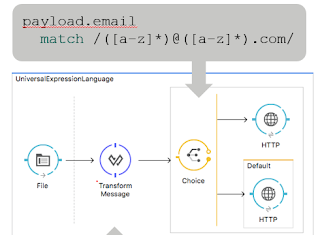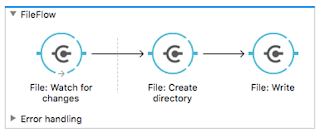Simplified Development and Studio 7 Improvements
Data Access and Transport Streaming
- Dataweave can be used directly in connectors.
- This should help developers have a common data access model
- Auto Caching of payloads larger than memory space
- Developers will have to be cognizant that the cache would most likely be not encrypted on disk and care will have to be taken when dealing with PHI or PCI data)
- Mule now allows access to payloads without the need to transform to java objects
- This will reduce clutter in flows and allow for developers to focus on the work and not transforming data.
Simplified Connectors (File, JMS, FTP and VM)
- Now operation based such as read file, write file, read jms, etc...
- Studio 7 will actually have new connectors for each operation which will make it a lot easier to use these types of connectors
- Retry logic will be built in
- Really looking forward to more information about retries as this is a pretty basic use case in data integration
- Mulesoft provided a simple flow with a filewatcher, File Create Directory and File Write connections to highlight how it will work
Try Catch Scope Improvements
- Try block introduced to allow try catches at any point in the flow
- Errors that can be caught are now displayed in Studio to allow for easier
- The catch block can propagate errors to calling flows
- Improved exception information and still able to get low level exception trace
- Example from the slide deck that highlights wrapping components and how the error types are called out:
1 2 3 4 5 6 7 8 9 10 11 12 13 14 15 16 | <try transactionalAction=”ALWAYS_BEGIN” transactionType=”XA”> <http:request .. /> <email:send .. /> <error-handler> <on-error type=”500_STATUS_CODE”> <notify-admin-of-possible-bug/> </on-error> <on-error type=”CONNECTIVITY”> <notify-admin-critical-error/> <on-error> <on-error type=”WRONG_ADDRES”> <send-email/> </on-error> </error-handler> |
Runtime Changes
Connectors distributor outside the runtime
- The runtime now isolates the connectors from the runtime which allows the connectors to be upgrade independently of the runtime. This will be be helpful if you need a new feature of a core connector, but don't have the time to wait for a full upgrade
- It appears that the Anypoint Exchange will be how the connectors will be managed and it also appears from the webinar that you will be able to extend your APIs as connectors in exchange and then pull them into Studio 7. If this works as it looks it will drive reuse and make it really use to use other teams APIs
Self Tuning Runtime
- Mule engine is now non blocking
- This will help with high load APIs and interested in any metrics Mulesoft will have around this
- Tunes based on the workload such as high IO processes will be handled differently than high CPU loads
- Global thread pool with reduced memory footprint
Mule API and SDK
Single Extensibility Layer
- Mulesoft will now have a single extensibility layer for Java components, Mulesoft flows and API specs (RAML or Swagger)
- Consistent UX for all connectors
- Enhanced metadata that will allow the Exchange to track dependencies of APIs, measure impacts and measure reuse
Mule 4 Migration
- 3.X will continued to be supported till 2021
- 3.9 is already planned
- Migration tools are being developed
My thoughts are Mule 4 is going to be an exciting update to the platform and I can't wait for the remaining parts of the webinar. I hope mulesoft provides additional in depth details around the items in the presentation.
If anyone would like the slide I have found them available at - https://www.slideshare.net/eaiesb/mule-4-and-anypoint-studio-demo
If you would like to have access to the Webinar or sign up for part 3 - https://www.mulesoft.com/demo/beta/mule-4


The blog is so interactive and Informative , you should write more blogs like this Mulesoft Online course
ReplyDelete